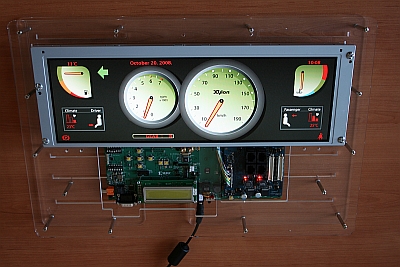Today cars include many electronic systems that make driving safer and drivers better connected. Digital information from systems like the GPS navigation, integrated mobile phones and Internet, night-vision radar, or a rear-view parking camera cannot be delivered to the driver by conventional Automotive Instrument Clusters (AICs) with analogue gauges and small displays.
Re-Configurable cluster solve the problem. The re-configurable AICs incorporate high-resolution TFT displays and can change graphically rendered information content during a drive, i.e. exchange or combine graphically rendered gauges and a night-vision view.

Click Photo To Enlarge!
Driver Expectations and Design Challenges Drivers expect reliable, stylish and attractive AIC with a dazzling PC-level graphics that look realistic and with the dynamic behavior of graphics instruments and video. The user interface must also be simple to use in different driving situations. Users are also used to personalizing their interfaces as with PC desktops.
Automotive electronics designers must find ways to work PC-level graphics on cost-sensitive electronics for AIC design. Extended graphics demands adoption of new components, design techniques and tools. Multiprocessing, dynamic memory interfacing, or GUI design are examples of new techniques that must be mastered by cluster designers. The selected silicon must withstand extended temperature ranges and be resilient to EMI.
Screenshots -
Automotive Instrument Cluster Demo running on the logiTAP Click Picture To Enlarge! At the heart of AIC is a microcontroller (MCU) integrating various communication peripherals (CAN, LIN, I2C, MOST, etc.) for communication with remote
Electronic
Control
Units (ECUs), volatile and non-volatile memories (ROM, RAM, FLASH), stepper motor controllers for analogue gauges, small display drivers, AD and DA converters, etc.
The MCU for re-configurable AIC design typically require a dedicated hardware graphics controller (GC) that offloads the graphics rendering burden. The GC can be added as a separated chip, or the GC and the MCU can be integrated into a single-chip ASSP product. The GC supports computing power hungry operations including video capture, bitmap operations, antialiasing, alpha blending, overlays, rotations, scaling, etc.
The dedicated ASSPs are developed to meet the majority of AIC design requirements, but their features may exceed needs of simpler AIC designs while more complex designs require additional chips. The cluster MCUs must run stable and reliable RTOS for automotive systems, certified middleware, and different applications. Inevitably and adoption of new silicon components forces automotive designers to give up legacy code and design from scratch. High-resolution graphics increases the size and complexity of AIC software. It must be expanded by a library of graphical objects and the application that handles these objects.
Click Picture To Enlarge!
Numerous contacts with renowned manufacturers of automotive electronic systems have enabled us to learn upon their needs, problems and desires. Lessons learned are built into the
Xylon demo platforms for the evaluation and development of automotive instrument clusters.
Watch demo video clips! Read More: - AMD FPGA in AIC Design
- Xylon Hybrid Instrument Cluster
- Xylon Re-Configurable Instrument Cluster
More about logicBRICKS in Automotive Systems:
- Surround View Driver Assistance - Parking Assistance
- Pedestrian Detection
- Lane Departure Warning
- Rear-View Camera
- Rear-Seats Entertainment System
- Performance Display